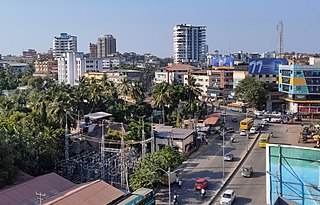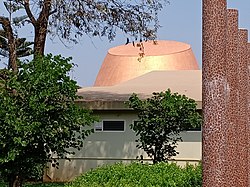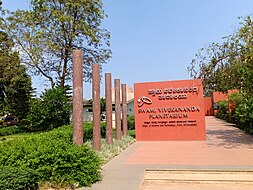
A planetarium is a theatre built primarily for presenting educational and entertaining shows about astronomy and the night sky, or for training in celestial navigation.

Mangalore, officially known as Mangaluru, is a major port city in the Indian state of Karnataka and on the west coast of India. It is located between the Arabian Sea and the Western Ghats about 352 km (219 mi) west of Bangalore, the state capital, 20 km north of Karnataka–Kerala border, 297 km south of Goa. Mangalore is the state's only city to have all four modes of transport—air, road, rail and sea. The population of the urban agglomeration was 619,664 according to the 2011 national census of India. It is known for being one of the locations of the Indian strategic petroleum reserves.
Nehru Planetariums are the five planetariums in India, named after India's first Prime Minister, Jawaharlal Nehru. These are located in Mumbai, New Delhi, Pune and Bangalore, plus there is a Jawahar Planetarium in Prayagraj, where Nehru was born.

Dakshina Kannada district is a district of Karnataka state in India, with its headquarters in the coastal city of Mangalore. It is part of the larger Tulu Nadu region. The district covers an area nestled in between the Western Ghats to its east and the Arabian Sea to its west. Dakshina Kannada receives abundant rainfall during the Indian monsoon. It is bordered by Udupi district to the north, Chikmagalur district to the northeast, Hassan district to the east, Kodagu to the southeast and Kasaragod district of Kerala to the south. According to the 2011 census of India, Dakshina Kannada district had a population of 2,083,625. It is the only district in Karnataka state to have all modes of transport like road, rail, water and air due to the presence of a major hub, Mangalore. This financial district is also known as the Cradle of Indian banking.

Kadri Park is a park located in Kadri Gudde. It is the largest park in Mangalore. This park contains a musical fountain and has hosted the Karavali Utsav. The park is famous for flower shows in Mangalore.

Deralakatte is a major educational, healthcare, commercial and residential locality in the south-eastern part of Mangalore city in the Dakshina Kannada district of Karnataka state. It is 9 km (5.6 mi) away from the Karnataka-Kerala state border. It is popularly known as the University Town owing to its student population and universities. The stretch from Thokottu junction to Konaje is known as the Medical corridor road due to the presence of many premium educational institutions and healthcare facilities. It is close to Mangalore University, Konaje, Mudipu Infosys, Soorya Infratech Park, Thokottu & Ullal. Ullal beach, Someshwar Beach, Pilikula Nisargadhama are some of the nearest tourist destinations. This locality houses the NITTE University, Yenepoya University, Father Muller Charitable Institutions, Fathers Mullers Homeopathic Medical college hospital and Kanachur Groups of institutions and Hospital. It is a largest University locality in Mangalore after Manipal university in terms of students from all over the country and other parts of the world.
Vamanjoor is a residential locality which falls within the city corporation of Mangalore in Karnataka, India. It is en route to Moodabidri and Karkala by National Highway 169.

Pilikula Nisargadhama is a multi-purpose tourist attraction, at Vamanjoor, eastern part of Mangalore city in Karnataka, managed by the District Administration of Dakshina Kannada. It is a major tourist attraction of Mangalore. It attracts large number of tourists due to the availability of multiple facilities.

Cricket is by far the most popular sport in Karnataka with International cricket matches attracting a sizeable number of spectators who are willing to pay more than the standard ticket price to get a chance to watch the match. The sports related infrastructure is mainly concentrated in Bangalore which also played host to the 4th National Games of India in the year 1997. Bangalore is also the location of the Sports Authority of India (SAI) which is the premier sports institute in the country. Karnataka is sometimes referred to as the cradle of Indian swimming because of high standards in swimming compared to other states.
The Indira Gandhi Planetarium, also known as the Patna Planetarium, is located in Patna's Indira Gandhi Science Complex. The planetarium was constructed through Bihar Council on Science & Technology at a total cost of about ₹110 million. It was conceptualised in 1989 by Bihar Chief Minister Shri Satyendra Narain Sinha with construction commencing in the same year, and opened for the public from 1 April 1993. It is named after senior Indian National Congress leader and former Prime Minister of India Indira Gandhi.

B. M. Birla Planetarium is a large planetarium in Chennai, India. The fifth B. M. Birla planetarium in the country, it is located at Kotturpuram in the Periyar Science and Technology Centre campus which houses eight galleries, namely, Physical Science, Electronics and Communication, Energy, Life Science, Innovation, Transport, International Dolls and Children and Materials Science, with over 500 exhibits. Built in 1988 in the memory of the great industrialist and visionary of India B. M. Birla, it is considered the most modern planetarium in India, providing a virtual tour of the night sky and holding cosmic shows on a specially perforated hemispherical aluminium inner dome. Other Birla planetariums in India include the M. P. Birla Planetarium in Kolkata, the Birla Planetarium in Hyderabad, and the planetariums in Tiruchirapalli and Coimbatore.

The Guwahati Planetarium is a center for astronomical education and research. Built in 1994, it is the only planetarium in Assam and the North-Eastern region of India. Its distinctive dome and sloping walls set it apart from the skyline of the area.

Bejai is one of the major localities in Mangalore city, Karnataka, India. The series of Bharath malls, Bharath mall & Bharath mall 2, are located here. It is one of the upscale & the busiest residential cum commercial localities of Mangalore. Bejai - Kadri belt is also regarded as the Manhattan of Mangalore with many high-rise buildings.
Science Centre, Surat is a multi-facility complex in Surat, Gujarat, India built by the Surat Municipal Corporation in 2009, the first of its type in western India. The complex houses a Science Centre, museum, an art gallery, an auditorium, an Amphitheatre and a planetarium. It has been designed by Ahmedabad based architectural firm, HCP Design, Planning and Management Pvt. Ltd.
John Richard Lobo, popularly known as J. R. Lobo, is an Indian politician with the Indian National Congress and former MLA of Mangalore South constituency in Karnataka, India. MLA J.R Lobo proposed the installation of musical fountain with laser show at Kadri Park, which is the largest lung space in the city. J.R Lobo also proposed the construction of the 3D 8K Planetarium at Pilikula in Mangalore, which was inaugurated in March 2018.

NITK Beach also known as Surathkal beach is on the Arabian Sea coast at Surathkal, 16 km (9.9 mi) north of the centre of Mangalore city, in the Dakshina Kannada district of Karnataka, India. It is a private beach that was later named after the nearby NITK.

Kusumbai Motichand Planetarium, the first projection planetarium in Asia, became operational at the New English School in Pune on 18 September 1954. It was named after the mother of Seth Motichand Shah, son-in-law of Seth Walchand Hirachand(1882–1953), the founder of the Walchand group of Industries. The venture of a planetarium building was possible because of the generous donation of Rs.50000 from Walchand Group in the early 1950s.

The city of Mangalore is proclaimed as the gateway to Karnataka and lies nestled between the blue waters of the Arabian Sea and the green, towering hills of the Western Ghats. The 184 square km city is spread out over the backwaters of the two rivers, Netravati and Gurpura.
Sasihithlu beach also known as Daibittil beach is located in Sasihithlu village, which is situated north of Mangalore city, in the state of Karnataka, in India. Sasihithlu Beach is situated approximately 6 km to the west of NH 66, and surrounded by the backwaters of the Pavanje and Shambhavi rivers. The two rivers meet at the beach. It is close to Mukka, one of the fastest developing localities of Mangalore. This beach hosted the Indian Open of Surfing in 2016 and 2017.

Kavoor is a suburban area and the name of a ward in the city of Mangalore in the Mysore division of the Indian state of Karnataka. Kannada and Tulu are the two most commonly spoken languages in Kavoor, with English being widely understood and spoken as well. It connects major cities like Surathkal, Kankanady, Kinnigoli, and Bajpe.





















